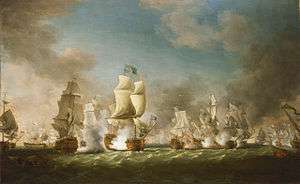Philip Vanbrugh
| Philip Vanbrugh | |
|---|---|
| Born | c. 1681 |
| Died | 22 July 1753 |
| Allegiance |
|
| Service/branch |
|
| Rank | Captain |
| Commands held |
|
| Battles/wars | |
| Relations |
John Vanbrugh (brother) Charles Vanbrugh (brother) |
Philip Vanbrugh (c. 1681 – 22 July 1753) was an officer of the Royal Navy. He served as Commodore Governor of Newfoundland.
Family
Vanbrugh was born in Chester and baptised there on 31 January 1682. He was the youngest child of Giles Vanbrugh, a London cloth merchant and later a sugar merchant in Chester, and his wife Elizabeth, née Carleton, herself youngest child of Sir Dudley Carleton and Lucy, née Croft. Vanbrugh's brothers included Captain Charles Vanbrugh RN MP and Sir John Vanbrugh, architect and dramatist.
Philip Vanbrugh married Mary Griffith in Arnold, Nottinghamshire on 24 July 1715 and they had one known child, Philippia, born 1716, la belle consulesse, who married Burrington Goldsworthy of Down House, Dorset, British consul at Leghorn, Italy and later at Cadiz. Their son, Lieutenant-General Philip Goldsworthy, became a favoured equerry to King George III and from 1772 his unmarried sister, Martha Caroline was sub-governess, under Lady Charlotte Finch, of the 15 royal children.[1]
Career

Philip Vanbrugh entered the navy, and after some years of service, was on 27 November 1710 appointed to command the 28-gun HMS Speedwell. In 1716 he was in command of the 32-gun HMS Charles Galley, and was sent to Gibraltar. He was still in command of her by 1718, when he served with the fleet under Admiral George Byng and was present at the Battle of Cape Passaro near Sicily on 11 August 1718. His elder brother Charles commanded HMS Burford during the battle. In 1721 Philip VanBrugh took command of HMS Breda, Vice-Admiral Francis Hosier's flagship at the disastrous Blockade of Porto Bello between 1726 and 1727. After months spent on the ineffective and costly operation, during which not a single British shot was fired, the British finally withdrew. 3,000 to 4,000 men had died from yellow fever and other tropical diseases, among them was Hosier, who died while the Breda was off Vera Cruz. Like many of the ships in that fleet Breda had suffered badly from worms attacking the hull, and she was broken up in 1730.
Vanbrugh survived the unhealthy posting, and in 1731 was given command of the 60-gun HMS York. He moved to take command of the 70-gun HMS Burford in 1734, and served in the fleet under Admiral Sir John Norris. Around 1736 he took command of the 50-gun HMS Chatham. On 14 June 1738 he was appointed governor of Newfoundland.[2] During his brief term as governor, Vanbrugh recorded information about the nature of the fishery and tallied the inhabitants of Twillingate and Fogo. In 1739 Vanbrugh was appointed a Commissioner of the Navy, resident at Plymouth. He died in that office on 22 July 1753, aged about 71.[3]
References
- ↑ Princes in the Making, a study of royal education, Morris Marples, Faber & Faber 1965
- ↑ The British chronologist: comprehending every material occurrence . . Vol II, G Kearsley, 1775
- ↑ John Charnock Biographia navalis; or, Impartial memoirs of the lives and characters of officers of the navy of Great Britain, from the year 1660 to the present time; drawn from the most authentic sources, and disposed in a chronological arrangement Vol IV, R Faulder, 1796
External links
| Political offices | ||
|---|---|---|
| Preceded by FitzRoy Henry Lee |
Commodore Governor of Newfoundland 1738–1738 |
Succeeded by Henry Medley |